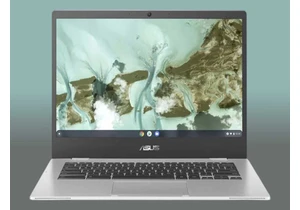If you’re wondering why you need Intel’s latest Core Ultra laptop processors, code-named Lunar Lake, the answer isn’t a simple one. But if you want to buy a Lunar Lake laptop, however, you’ll probably understand the differences between the various chips almost immediately.
Intel unveiled what it’s calling the Core Ultra Series 2 at a launch event in Berlin on Tuesday. In total, there are nine new Lunar Lake processors, which will begin shipping inside laptops from PC makers like Acer, Asus, HP, and Lenovo very soon: September 24. Preorders begin now.
A few months ago, Intel unveiled the guts of the new Lunar Lake architecture, offering a sneak peek into how much performance it will offer and how much power it will consume. Today we have a better idea: Intel is promising about a 30 percent improvement in terms of gaming over last year’s Meteor Lake chip, while consuming less power — with some hard numbers to back it up. That’s a nice one-two punch for those people who want longer-lasting laptops without giving up too much performance.
What you’ll probably appreciate, though, is a relative return to simplicity. For the last several years, simply describing a laptop processor meant trying to explain a tangled web of cores, threads, clock speeds, caches, and GPUs — with twists and tweaks all over the place.
Instead, all of the Lunar Lake chips begin with “2” to describe them. They all end in “V.” They all contain the same number of performance cores, efficiency cores, and threads. Jumping up to a faster Lunar Lake model number means adding 200MHz or so in clock speed, with a corresponding increase in GPU performance. That’s about it.
And yes, these new Core Ultra Lunar Lake chips are (mostly) qualified to be called Copilot+ PCs, with NPUs cresting 45 TOPS of AI performance and above. But Intel is taking a much less breathless, more realistic approach to AI than before.
Further reading: The best laptops for any budget
Intel’s Core Ultra (Series 2) Lunar Lake processors
Intel refused to call Meteor Lake a 14th-gen Core chip; in the same vein, Lunar Lake isn’t a 15th-gen Core chip, either. Instead, both chips are confined to the Core Ultra brand — though Intel isn’t really playing up the Core Ultra Series 2 moniker, either. Intel vice president Josh Newman, the general manager of product management, told reporters that Intel will still sell Meteor Lake chips to customers, leaving both Core Ultra chips in the market for now.
The new “V”-series designation is a new twist, too. Robert Hallock, a vice president in Intel’s Client Computing Group and general manager of AI marketing, said that the “V” designation was in response to customers who wanted a unique designation for Lunar Lake. You will eventually see familiar “S,” “U,” and “H”-series chips, on a “similar architecture, but different product,” Intel executives said, probably implying a version of the Arrow Lake chip that’s due sometime this fall, too.
All of the new Lunar Lake chips contain four P-cores and four E-cores, with the same number of threads for each. They’re differentiated in two ways: first, they either have 16GB or 32GB of DRAM, embedded right in the chip package themselves. But otherwise, they just have incremental improvements in CPU and GPU clock speed, up and down the stack — just like the way they used to be.
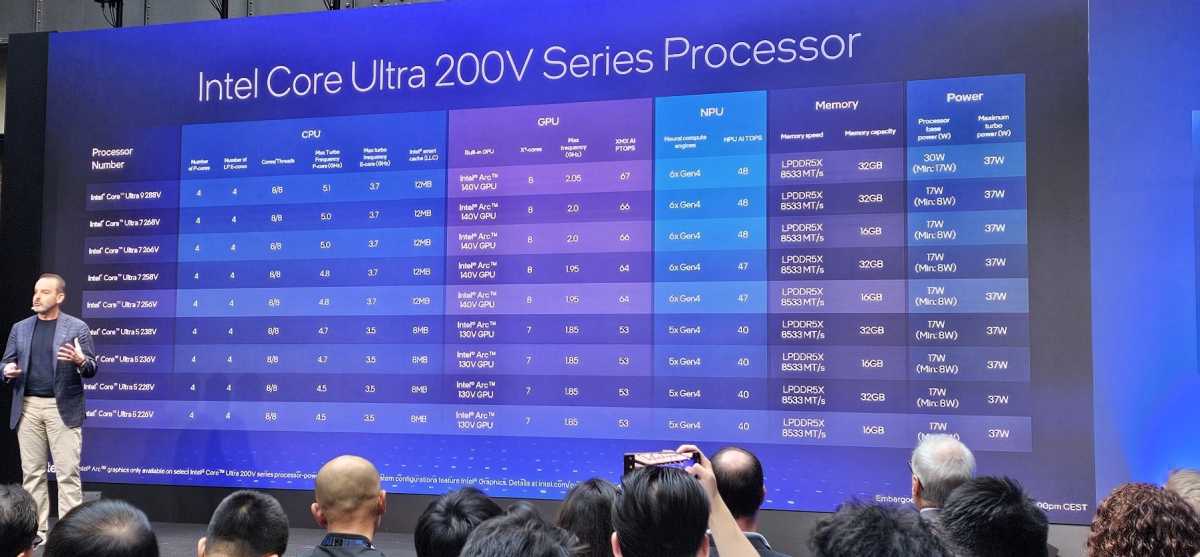
Mark Hachman / IDG
Mark Hachman / IDG
<div class="scrim" style="background-color: #fff" aria-hidden="true"></div>
</div></figure><p class="imageCredit">Mark Hachman / IDG</p></div>Naturally, Intel isn’t releasing the prices of the new Lunar Lake chips., as they’re sold directly to laptop makers. But Hallock said that the overarching principle was to offer partners and customers as close to the full capabilities of the Lunar Lake architecture to every customer, and let the price of the end product dictate the performance that customer will buy. That might sound somewhat obvious — but again, it hasn’t always been this way, especially recently.
The only subtle wrinkle to Intel’s chip lineup is that not all of the Lunar Lake chips will be Copilot+ capable, which is a slight surprise. Instead, some of the slower Lunar Lake processors dip below 45 TOPS, which has been the informal dividing line between what is a Copilot+ PC and what isn’t. Intel is still tweaking the NPU by adjusting the frequency and the number of NPU units, producing the Core Ultra 7 258V (47 TOPS) and the Core Ultra 7 266V (48 TOPS). It just won’t tell us what it’s doing. (I asked.)
Intel’s prior Core Ultra processor, Meteor Lake, shipped on Dec. 14, 2023, after Intel discussed the Meteor Lake architecture and announced its clock speeds and model names, too. But there was one key issue: Yes, the 14th-gen Core Ultra chips ushered in the AI PC — but without sufficient TOPS to let them be used as a Copilot+ PC.
Inside Intel’s newest Core Ultra, Lunar Lake
Intel’s Lunar Lake chip changes in a few significant ways from its earlier chips. (For those of you who have been following our earlier coverage and wish to jump ahead to how performance differs, please do so. Otherwise, this section will recap some of the key features of the Lunar Lake architecture, using more details of the Xe2 GPU as a transition into performance.)
As referenced above, the key adjustment from a laptop perspective is Intel’s decision to build in the system DRAM inside the chip package itself. We’ve become used to PCs shipping with RAM slots, which can be upgraded with more memory over time. Laptops also include this feature — but fewer are internally accessible, and some laptops come with memory soldered to the motherboard itself. Intel is betting that those of you buying productivity laptops with Lunar Lake chips inside won’t care about upgrading the memory, and that either 16GB or 32GB will be sufficient.
Further reading: Intel’s Lunar Lake laptops won’t let you upgrade your RAM, and that’s fine
Otherwise, Intel has continued down the path of aggressively reducing power. While Meteor Lake introduced efficiency (E-cores) and low-power E-cores, Lunar Lake’s E-cores are simply all E-cores, if that makes sense. Lunar Lake’s E-core performance is basically double that of Meteor Lake, Intel executives have said. And, given that there are four E-cores in Lunar Lake, versus two low-power E-cores in Meteor Lake, you might say (as Intel does) that multithreaded E-core performance has almost quadrupled in a generation’s time.
And then there’s one of the more higher-profile changes: no more hyperthreading. For decades now, Intel’s Core chips have been able to run two threads per processor core, increasing performance. But Intel has said eliminating the SMT feature helps Intel optimize for performance per watt and performance per area — and that’s the overarching mantra for Lunar Lake.
AI, of course, is one of the key thrusts for Intel and its competitors. How important it is an interesting question, especially because AI encompasses both AI processing in the cloud (such as Google Gemini, or Microsoft Copilot) and the on-chip AI processing that chipmakers love to talk about.
How much the onboard NPU will be used isn’t really clear. But what Intel’s marketing team cares most about is that the “NPU4” core now produces up to 48 TOPS, meaning that laptop makers can now add a Copilot+ sticker (and its related Windows features) to Lunar Lake laptops.
Finally, Lunar Lake has added what Intel calls the ‘Xe2″ GPU, the long-awaited variant that should show up in the upcoming discrete “Battlemage” graphics cards for desktops. Our earlier story goes into more detail about the actual architecture of the Xe2 GPU, including the updated ray-tracing unit, the eight 512-bit vector engines and the eight 2,048-bit Xe Matrix Extension engines.
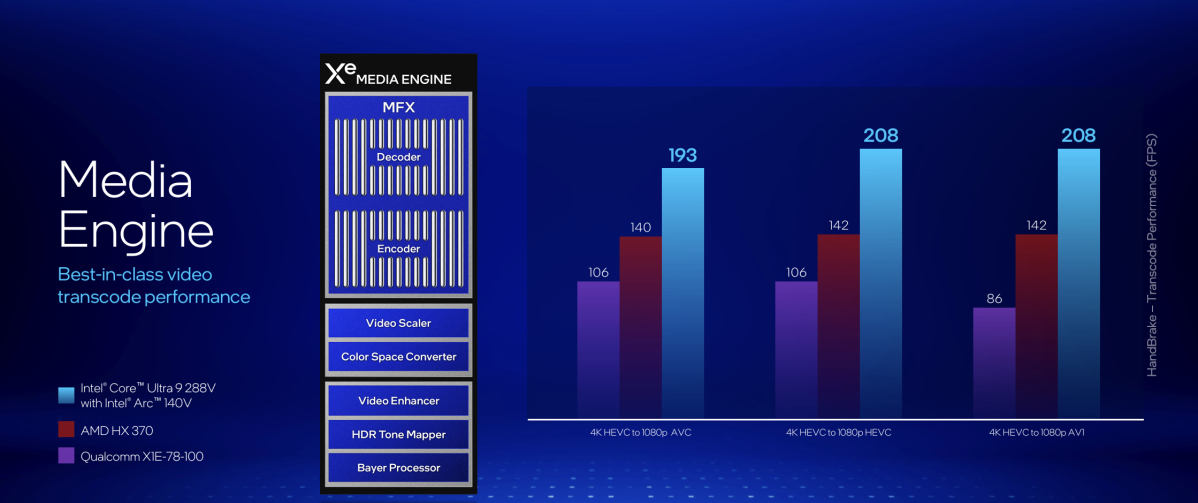
Intel
<div class="lightbox-image-container foundry-lightbox"><div class="extendedBlock-wrapper block-coreImage undefined"><figure class="wp-block-image size-large enlarged-image"><img decoding="async" data-wp-bind--src="selectors.core.image.enlargedImgSrc" data-wp-style--object-fit="selectors.core.image.lightboxObjectFit" src="" alt="Intel Lunar Lake media engine performance" class="wp-image-2446174" width="1200" height="504" loading="lazy" /><figcaption class="wp-element-caption">Intel’s estimates of its media-engine performance.</figcaption></figure><p class="imageCredit">Intel</p></div> </div></figure><p class="imageCredit">Intel</p></div>What’s new here is what Intel wouldn’t tell us before, including the clock speeds and memory. The Lunar Lake product matrix reveals that you’ll be able to choose from an Xe2 GPU with either 7 or 8 Xe2 cores, with clock speeds ranging from 1.85GHz to 2.05GHz. While it’s not a perfect metric, TOPS is also helpful to understand the range of GPU performance. The slowest Ultra 5 226V chip produces 53 TOPS between its CPU/GPU/NPU, while the fastest Core Ultra 9 288V produces 67 TOPS.
How fast is Lunar Lake? Here’s what Intel says
So how fast is Intel’s Lunar Lake chip? That might not be the right question. Qualcomm has been earning praise for its power-sipping Snapdragon chips. AMD’s mobile Ryzens have aimed mainly at performance. And Intel? They
Autentifică-te pentru a adăuga comentarii
Alte posturi din acest grup

If you’re a Gmail user, you need to be particularly careful right now

Remember back when Windows 11 first came out and Microsoft gave every
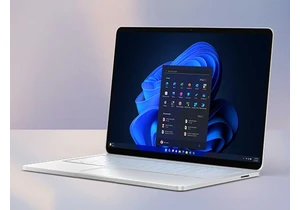

On Friday afternoon, Intel confirmed what everyone already knew: that
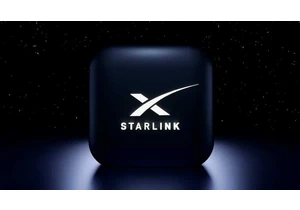
I recently moved to a much more rural area, so getting Starlink set u

I review a lot of laptops and I’ve noticed many of them come with a “
